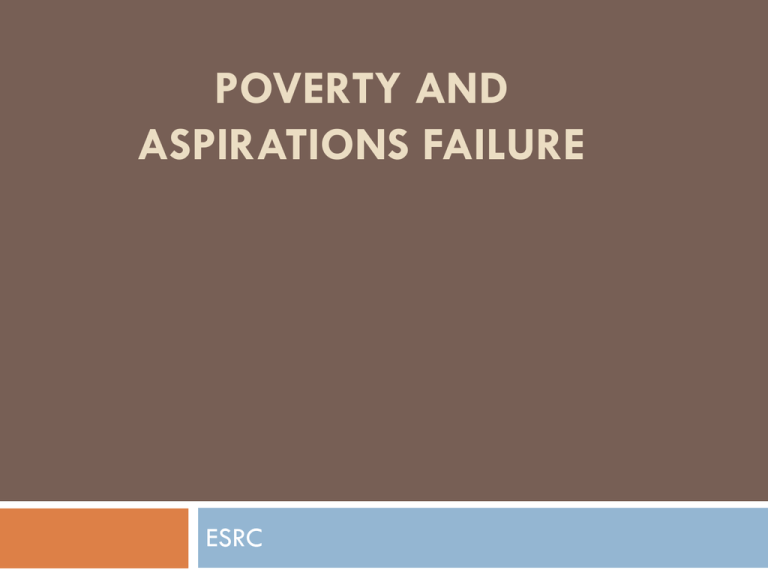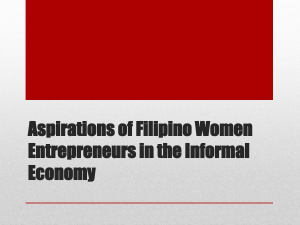
POVERTY AND
ASPIRATIONS FAILURE
ESRC
Overview
Poverty traps and adaptive preferences: beyond
conventional accounts of deprivation and
disadvantage.
The design of pro-poor interventions
Poverty Traps: Two views
Persistent Poverty Due to External Constraints
Credit
Market Imperfections, Poor Nutrition, Network effects
Implicit Assumption: Poor but Rational
Persistent Poverty due to Internal Constraints
Implicit
Assumption: Irrational, hence poor?
60 % of Americans think that the poor "are lazy or lack
willpower" (World Values Survey, Alesina et al, 2001).
Lack of Self-Control among the poor could lead to Poverty
Trap (Banjeree-Mullainathan, 2010; Bernheim-Ray-Yelteki,
2011)
Poverty & Beliefs
Alberto Bandura :
"People's beliefs in their efficacy influence the choices they
make, their aspirations, how much effort they mobilize in a
given endeavor, how long they persevere in the face of
difficulties and setbacks....”
Self-efficacy beliefs: ‘Beliefs in the capacity to achieve
desired outcomes through one’s effort’
Persistent Poverty has been associated with:
‘Lack of hope’ -- Mookherjee(2003)
Lack of the capacity to aspire -- Appadurai(2004)
More external ‘Locus of Control’ – Moreira (2003),
Macleod(1995): America, LSYPE(2006)
Internal Constraints – Cause or Effect ?
Is it that the poverty persists because the poor lack hope
and motivation to pull themselves out of poverty? OR…
Is it that `the poor may exhibit the same basic weaknesses
and biases as do people from other walks of life, except
that in poverty, ....the same behaviors ...lead to worse
outcomes’ ? (Bertrand et al (2004))
In a theoretical paper (Dalton, Ghosal and Mani), we
examine this interaction between poverty and individual
weakness/bias – and whether it can explain the
psychology of the poor, and their ‘aspiration failure’
Evidence
Beliefs, Aspirations and Poverty: Moreira (2003),
Rabow et al., (1983), MacLeod, (1995), Walker, (1997)
and Frankerberger et al., (2007), Bernard et al.
(2011), Longitudinal Study of Young People in England
(2006), Rotter, (1954), Furnham, (1986), Poortinga et
al., (2008), Arjun Appadurai (2004).
Poverty and Low Aspirations: Lack of Opportunity or
Information-Miguel and Kremer (2004), Duflo et al.
(2010), Jensen (2010)
Pessimism and Low Aspirations: Cause or Consequence
of Poverty? Banerjee and Duflo (2011), Akresh et al.
(2010), Gutman and Akerman (2008).
Conceptual Framework: Dalton, Ghosal
and Mani (2012)
(A) Preferences are reference-dependent, where the
reference point is a person’s Aspiration Level
(B) Aspirations are Endogenous Reference points (Shalev
(2000), Koszegi-Rabin(2006), Dalton-Ghosal (2012 a,b))
Rich and Poor have the same preferences and draw from the
same distribution of ‘innate’ ambition (initial aspirations)
i.e. people’s effort and aspirations feed into each other. Thus,
they are jointly chosen such that a person’s aspiration is the
rational expectations equilibrium outcome, given his effort
(C) People – both rich and poor -- have a behavioral bias
in setting aspirations.
Behavioral Bias in Setting Aspirations
Aspirations Evolve with Effort
“Every ceiling, when reached, becomes a floor...”
-- Aldous Huxley
In setting their life goals, individuals recognize that
Higher Aspirations require greater Effort to be achieved…
…But do not anticipate that Aspirations evolve with Effort,
through outcomes realized
Survey Evidence:
Easterlin(2001): People underestimate how preferences evolve as
their income changes, over their lifetime
Knight & Gunatilaka(2008): Migrants underestimate how their
preferences adapt with their location – ending up less happy
than rural and urban non-migrants
Mechanism: How Poverty causes
Aspirations Failure
Suppose a poor person draws the same initial aspiration
as a rich person…
Both of them choose effort level taking aspiration g as
given, but…
a poorer person chooses lower effort for a given
aspiration level because greater risk reduces his Expected
Marginal Benefit of effort
However, Aspirations evolve with Effort – hence,…
In (long run) equilibrium, the poor person ends up farther
away from his best possible outcome than a rich person,
i.e. he is more prone to aspirations failure
Poverty Traps
WEALTH-BASED: Low effort is
optimal
ASPIRATION BASED: Low
effort is sub-optimal
Related papers
Ray (2006) provides a non-mathematical exposition of
how socially determined aspirations contribute to
poverty persistence.
Closely related papers on aspirations include
Bogliacino and Ortoleva (2011), Genicot and Ray
(2011) and Stark (2006), all of which have a more
macro focus.
Banerjee and Mullainathan (2010) provide a model to
understand how poverty may persist due to a different
behavioral constraints -- a lack of self-control in the
consumption of certain goods.
Subjective well-being data and poverty
If reference points adjust to the current state of the
individual, relating preference satisfaction and reported
SWB is problematic even in the long-run (Dalton and
Ghosal (2011a,b)): SWB data as a measure of
deprivation and disadvantage.
Eg. Poverty and happiness: A “satisfaction” paradox Sen
(1999), Biwas-Diener, and Diener (2001), Rojas (2004).
If an economy provides more social mobility and increase
people expectations and aspirations, it may result in a
decrease of well being self-report. In fact, raising
aspirations can be a route out of poverty traps.
Measuring the impact of shocking
aspirations
Fieldwork 1: “Dream Building”, Kolkata
Reseachers: Ghosal, Mani, Roy and Jana (Durbar).
Examine the impact of “Dream Building” program that aims to
raise aspirations and self-perception of a marginalised group,
sex workers, impact on actions (e.g. savings behaviour) to
improve their own well-being.
The training program will be carried out in collaboration with
the Durbar Foundation, an NGO working with sex workers in
Kolkata, India.
It consists of 8 sessions, during which experienced trainers (some
of whom are from the same community) associated with Durbar
will attempt to lift aspirations of the participating sex-workers
through novel methods of discussion and engagement.
Pilot Results: Pre-vs-Post Analysis
Opinio Shame
n about
self
Kali
Post
Kali*Post
Constant
Adj. R-sq
(1)
(2)
Discrim- Self
Locus Decisi
ination
confiden of
on
ce
control makin
g
(3)
(4)
(5)
(6)
-0.24
0.17
0.13
0.14
(0.16)
(0.14)
(0.13)
(0.16)
0.29**
-0.29** 0.28**
0.39**
(0.14)
(0.14)
(0.12)
(0.15)
0.83** 0.06
*
(0.11) (0.09)
0.28
0.08
-0.16
-0.05
-0.30*
-0.24*
0.21
(0.21)
(0.20)
(0.18)
(0.22)
(0.17)
(0.13)
(0.16)
0.60**
*
0.29**
*
0.00
0.39***
0.06
0.94** 0.78*
*
**
(0.10)
(0.10)
(0.09)
(0.11)
(0.08)
(0.07)
(0.08)
0.20
0.11
0.05
0.12
0.54
0.07
0.19
66
67
67
67
68
66
No. of observations 60
Mobil
ity
0.34** -0.01
*
(0.12) (0.09)
-0.21*
0.22*
*
(0.11)
(7)
(0.12)
Pilot: Treatment-vs-Control
Kali
Treat
Kali*Treat
Opinio
n about
self
Shame
Discrim Self
-ination confide
nce
Locus Decisio Mobilit
of
n
y
control making
(1)
(2)`
(3)
(4)
(5)
(6)
(7)
0.67*** 0.25
-0.03
0.50*
0.42
0.25
(0.23)
(0.16)
(0.29)
(0.26)
(0.22)
0.75**
*
(0.10)
0.89*** -0.25
-0.72
0.53**
0.56**
0.25
(0.17)
(0.47)
(0.23)
(0.21)
(0.17)
(droppe
d)
-0.40
-0.37
(0.32)
(0.28)
-0.50** 0.75**
*
(0.25) (0.11)
(0.25)
(0.20)
-0.62** 0.00
(0.25)
(0.28)
-0.00
0.25
1.00*** 0.25
0.33*
(0.15)
(0.18)
(0.45)
(0.20)
Adj. R-sq
0.43
0.12
0.02
No. of
observations
41
42
35
Constant
1.00**
*
(0.08)
0.00
(0.19)
0.75**
*
(0.16)
0.10
0.13
0.08
0.82
42
41
42
42
(0.07)
Fieldwork 2: Argentine
CLASSICAL MUSIC ORCHESTRAS FOR CHILDREN FROM DISADVANTAGED
BACKGROUNDS, BUENOS AIRES PROVINCE, ARGENTINA
People: Dalton, Ghosal, Mani and Waldinger
Aim: To examine whether
(a) the aspirations of children from very deprived
backgrounds are raised by their participation in
classical music orchestras;
(b) Regular participation has spill-overs in other
dimensions such as educational performance.
4000 children, 40 schools (20 treated, 20 control)
Baseline survey done;
First stage of randomisation implemented.
Policy Implications
Pro-poor policy interventions need to shock internal
constraints (such as aspirations), in addition to relaxing
external constraints.
Changing Beliefs are important to break aspiration
failure driven poverty Traps. Could do this by:
Changing Initial Aspirations (of Parents, for instance)
SPOKE Program in UK
Creating Relevant (‘similar’) Role Models
Bandura Project on Country-specific soap operas,
developed with Population Services International








